Gokyo and Everest Helicopter Return to Lukla: The Everest Base Camp Fly Back by Helicopter Tour is a carefully crafted itinerary for those looking to explore the Everest region in a unique blend of trekking and luxury helicopter travel. Nestled in the northeastern corner of Nepal, the Khumbu region offers some of the world’s most awe-inspiring landscapes, including towering mountains, glaciers, icefalls, high-altitude lakes, and picturesque valleys. This 16-day adventure takes you on a journey through diverse landscapes, where you will trek to the base of Mount Everest and reach the iconic vantage point of Kala Patthar. To make the experience even more extraordinary, the return journey from Everest Base Camp is done in a helicopter, offering panoramic views of the region.
The Gokyo Lake and Everest Base Camp Trek is one of the most sought-after trekking routes in the world, offering trekkers a chance to explore Nepal’s stunning Everest region. The region is renowned for its beauty and diversity, attracting travelers, trekkers, nature lovers, and mountain enthusiasts from around the globe. This trek takes you across varied terrains, from the lush green forests and deep wilderness of central Nepal to the high alpine grounds, glaciers, icefalls, and pristine lakes. Along the way, you will experience the rugged beauty of the Himalayas and reach the foothills of the highest mountains on Earth, including Mount Everest itself.
This 16-day trek not only allows you to witness some of the world’s most spectacular landscapes but also provides the opportunity to immerse yourself in the culture and traditions of the Sherpa people. The journey takes you through Sherpa villages, where you’ll get a glimpse of their way of life, their ancient monasteries, chortens, and gompas. As you trek through these beautiful landscapes, you’ll gain a deeper understanding of the culture that has been shaped by the towering peaks of the Himalayas.
The Everest Base Camp and Gokyo Lake Trek offer a gateway to some of the most breathtaking vistas of the Himalayas, with views that will leave you speechless. From the lush greenery of the lower altitudes to the stark beauty of the high alpine zone, you’ll witness a wide variety of ecosystems and landscapes. The trek takes you to an elevation of over 5,500 meters (18,000 feet) at Everest Base Camp, providing a chance to experience high-altitude trekking and the challenges it presents. But the reward is unparalleled – the opportunity to stand at the foot of the world’s tallest mountain, surrounded by towering peaks and stunning glaciers.
The Everest region is a land of contrasts, with its elevation ranging from 3,300 meters (11,000 feet) to the towering peak of Mount Everest at 8,848.86 meters (29,032 feet). The region is not only known for its natural beauty but also its rich biodiversity and unique microclimates. This trek is not just about physical endurance but also about learning the history, culture, and way of life of the Sherpa people, who have called these mountains home for centuries.
Throughout this 16-day adventure, you’ll experience the best of both worlds: the thrill of trekking through some of the world’s most stunning landscapes and the comfort of traveling in a helicopter for a scenic return from Everest Base Camp to Lukla. The helicopter ride provides a once-in-a-lifetime opportunity to view the Khumbu region’s awe-inspiring mountains, glaciers, and valleys from a bird’s eye perspective.
The trek begins in Kathmandu, Nepal’s vibrant capital, where you’ll have time to explore ancient temples, bustling markets, and soak in the rich history and culture of this UNESCO World Heritage city. From there, you’ll take a thrilling flight to Lukla, the gateway to the Everest region, and begin your trek toward Everest Base Camp. Along the way, you’ll pass through iconic Sherpa villages such as Namche Bazaar, Tengboche, and Dingboche, each offering a glimpse into the daily life of the Sherpa people.
As you approach Everest Base Camp, you’ll have the opportunity to hike up to Kala Patthar, one of the best viewpoints of Mount Everest, where you can enjoy panoramic views of the world’s tallest mountain and its surrounding peaks. After reaching Everest Base Camp, the trek continues to Gokyo Lake, a serene high-altitude lake known for its stunning turquoise waters and breathtaking views of Mount Everest and the surrounding peaks.
The journey culminates in a scenic helicopter flight back to Lukla, where you can take in the majestic beauty of the Khumbu region from the comfort of your seat. This is a perfect blend of adventure, culture, and luxury, offering a once-in-a-lifetime opportunity to experience the Everest region in a way few others have.
The Gokyo Valley, Everest Base Camp, and Helicopter Return to Lukla Trek is the perfect choice for those who want to experience the best of the Everest region, from its stunning landscapes to its rich culture, all while enjoying the convenience and luxury of a helicopter ride back to Lukla. Don’t miss the chance to fulfill your dream of trekking in the shadow of Mount Everest and experiencing the beauty and majesty of the Khumbu region.
Overview
Best Time To Visit
The best time to visit the Everest Base Camp and Gokyo Lake is during the spring (March to May) and autumn (September to November) seasons. These months offer the most favorable weather conditions for trekking in the Everest region, with clear skies, mild temperatures, and stable weather. Spring brings beautiful blooming rhododendrons, making the landscapes vibrant, while autumn provides crisp air and exceptional visibility of the Himalayas, along with vibrant fall colors in the lower regions. These seasons offer the most pleasant trekking conditions, with fewer chances of rain and snow, unlike the monsoon (June to August), which brings heavy rainfall and unstable trails, or winter (December to February), where extreme cold and snow-covered paths make trekking more challenging. Overall, spring and autumn provide the best opportunities for a comfortable and scenic trek to Everest Base Camp and Gokyo Lake.
Difficulty level
The difficulty level of the Everest Base Camp and Gokyo Lake Trek is considered moderate to challenging. This trek involves high-altitude hiking, with elevations reaching over 5,000 meters (16,404 feet) at Everest Base Camp and Gokyo Lakes, which can make acclimatization crucial. The terrain is varied, including steep ascents, rocky trails, and narrow paths, particularly in higher sections. While the trek does not require technical climbing skills, trekkers need to be physically fit and prepared for long, strenuous days of walking, often on uneven terrain. The altitude can cause fatigue, dizziness, or altitude sickness, so gradual acclimatization days, such as those in Namche Bazaar and Dingboche, are vital for success. The trek also requires carrying a daypack, and some remote sections may lack amenities, so trekkers need to be mentally prepared for limited facilities. Overall, the trek is suitable for those with a good level of fitness and prior trekking experience at high altitudes.
Physical Fitness and Requirements
Trekking to Everest Base Camp and Gokyo Lake requires a good level of physical fitness and preparation. The trails lead through rugged terrain, at high altitudes, and often involve long days of hiking, with significant ascents and descents. To ensure a safe and enjoyable experience, trekkers should have a basic level of fitness and should be accustomed to regular physical activity, such as walking, running, or hiking, ideally with some elevation gain.
Cardiovascular fitness, stamina, and the ability to walk for several hours a day are essential. Prior to the trek, it’s advisable to engage in activities that build strength, endurance, and flexibility, such as hiking on inclines, climbing stairs, and building leg strength. While the trek is suitable for reasonably fit individuals, those with previous trekking experience at moderate altitudes will find it easier to adapt.
Acclimatization is key to preventing altitude sickness, so trekkers should pace themselves, stay hydrated, and follow the guidance of their experienced guide. Those with any underlying health issues or concerns should consult with a doctor before embarking on the trek to ensure they are physically prepared for the challenges at higher altitudes.
Enviornment
The Everest region in northeastern Nepal is one of the most spectacular natural environments on Earth, offering trekkers unparalleled views of towering snow-capped peaks, glaciers, and unique alpine ecosystems. Known for its pristine beauty and fragile ecology, the region spans a variety of landscapes, from lush forests of rhododendron and pine at lower elevations to barren, rocky terrain above 4,000 meters.
The Sagarmatha National Park, a UNESCO World Heritage site, is home to diverse wildlife, including the snow leopard, red panda, and Himalayan tahr. The area is also famous for its glaciers, such as the Ngozumpa Glacier and Khumbu Icefall, which are vital to the region’s rivers. The region’s climate is harsh, with temperatures dropping significantly at higher altitudes and high winds, especially during winter months. The ideal trekking conditions are found during spring (pre-monsoon) and autumn (post-monsoon).
Trekking in this region also offers a glimpse into the rich Sherpa culture, with their traditions, monasteries, and stone houses. However, increasing tourism has raised environmental concerns, prompting initiatives like the Sagarmatha Pollution Control Committee (SPCC) to promote sustainable trekking practices and protect the delicate ecosystem. The Everest region’s environment remains a treasure for nature lovers, trekkers, and adventurers alike, with efforts ongoing to preserve its natural and cultural integrity.
Climate and Weather in the Everest Region
The climate in the Everest region is characterized by significant variation in temperature and conditions, depending on the altitude and time of year. During Spring (March to May), the weather is generally clear with mild daytime temperatures around 10°C to 15°C in lower altitudes, though it can drop below freezing at night at higher elevations. This season offers excellent trekking conditions, along with stunning mountain views.
In Autumn (September to November), temperatures remain mild, and the weather is stable, making it another ideal trekking period. Daytime temperatures are similar to spring, but nights are colder at higher altitudes. Winter (December to February) brings extreme cold, with temperatures dropping as low as -10°C to -20°C at higher elevations. This season sees fewer trekkers due to harsh conditions, but those who do trek must be well-prepared for the cold and the risk of altitude sickness.
The Monsoon season (June to August) is the least favorable, with heavy rains causing potential landslides and trail hazards. The weather is often cloudy, and visibility is poor, especially in higher altitudes. The monsoon season is not recommended for trekking in the Everest region due to these unpredictable weather conditions.
Weather Challenges:
The weather in the Everest region can be unpredictable, and trekkers must be prepared for a range of conditions, including extreme cold, wind, and rain, particularly at higher altitudes.
- Altitude-related Weather: As you ascend, the temperatures drop significantly. At Everest Base Camp and Gokyo Lake, temperatures can drop below freezing, especially at night, even during the peak trekking seasons (spring and autumn). Snowfall and strong winds are common at higher elevations, particularly during winter months (December to February).
- Unpredictable Weather Patterns: The Everest region is known for its rapidly changing weather. While the daytime can be relatively warm in the lower altitudes, conditions can change quickly, with sudden cold fronts, rain, or snow, particularly in the monsoon season (June to August). The monsoon brings heavy rainfall, which can make the trails slippery and cause river levels to rise, making it harder to traverse.
- Wind Chill: The higher you go, the colder it gets, and wind chill can make temperatures feel even colder than they actually are. On summits like Kala Patthar, which is exposed to winds, temperatures can feel extremely harsh, especially in the early mornings before the sun rises.
- Cloud Cover and Limited Visibility: On some days, cloud cover can obscure views of the mountains, limiting visibility. This can be particularly challenging for trekkers hoping to enjoy panoramic mountain vistas or for photographers.
Alternatives to Reach Lukla
Due to the challenging weather conditions, reaching Lukla, the starting point for Everest region treks, can be difficult at times. The main way to reach Lukla is via a flight from Kathmandu to Lukla Airport, but this can be affected by weather disruptions. Here are alternative ways to reach Lukla or bypass potential flight delays:
- Helicopter Flight: If regular flights to Lukla are canceled due to weather, one alternative is to take a helicopter flight. Helicopters are often less affected by weather conditions and can reach Lukla directly, though they may be more expensive. Some tour packages include helicopter rides to and from Lukla, particularly when flights are disrupted. Helicopters can be a faster and more reliable way to reach Lukla, although availability can be limited during peak seasons.
- Trekking to Lukla: If flights to Lukla are delayed or canceled, an alternative is to trek from Jiri or Salleri to Lukla. This adds a few days of trekking (usually about 4-6 days) before you even begin the Everest Base Camp trek. This option allows you to skip the flight entirely and still enjoy the trekking experience. While it’s a longer route, it offers beautiful landscapes and a chance to experience more of the lower-altitude Nepali villages.
- Drive to Phaplu: Another option is to drive to Phaplu, a town in the lower Solu-Khumbu region, and trek from there to Lukla. The drive from Kathmandu to Phaplu can take 8-10 hours by jeep or bus. From Phaplu, the trek to Lukla is around 3-4 days, allowing you to skip the flight while still beginning your trek in a less-trekked region.
While Lukla flights are the most common and preferred method, these alternatives provide flexibility and options in case of flight disruptions, particularly in the unpredictable weather conditions of the Everest region.
Guides and Porters
On your trek with Alpine Club of Himalaya, we provide expert guides and porters to ensure your trek is safe and enjoyable. Each group of trekkers will be accompanied by a skilled English-speaking guide who is well-versed in the region’s terrain, culture, and high-altitude trekking protocols. The guide will help you navigate the trails, provide insights into local traditions and natural wonders, and assist in case of any emergency. Additionally, we assign one porter for every two trekkers to carry your luggage and gear, which makes the trekking experience more comfortable. If you are trekking solo, we will provide a porter based on your requirements. Our porters are experienced in handling high-altitude trekking and will help maintain a manageable pace. All necessary expenses for the guides and porters, including their salary, food, accommodation, and insurance, are covered by your trekking package, ensuring that you can focus on enjoying the adventure without logistical concerns.
Accommodation and Food
Accommodation in the Everest region primarily consists of tea houses and lodges, offering basic but comfortable rooms with shared bathrooms. These tea houses are simple, providing trekkers with a cozy environment to rest after a long day of trekking. Meals at these accommodations include traditional Nepali dishes such as dal bhat (lentil soup with rice), momo (dumplings), and a variety of international options, catering to all tastes. The food is generally nutritious and helps provide the energy needed for the challenging trek ahead. As trekkers ascend, the food becomes more basic due to the high-altitude conditions, but most tea houses will offer a variety of options to keep you energized throughout the journey.
Drinking Water
Staying hydrated during your trek to Everest Base Camp is essential. While there are several sources of drinking water along the trekking route, such as streams and water stations, it is recommended to carry a water purification system such as iodine tablets or a water filter to ensure the water is safe to drink. Many tea houses offer bottled water for purchase, but the use of plastic bottles is discouraged to minimize environmental impact. Trekking in the Everest region requires careful attention to water purification to avoid waterborne diseases and stay healthy throughout your adventure.
Travel Insurance
Before embarking on the Everest Base Camp trek, it is crucial to have comprehensive travel insurance. Your insurance policy should cover medical evacuation and high-altitude trekking. This is essential due to the remote nature of the region, where access to medical facilities is limited. Travel insurance will provide peace of mind in the event of injury, illness, or any other unforeseen circumstances. It is always advisable to verify that your insurance covers emergency evacuation and rescue services in case of altitude sickness or other health-related issues.
Passport and Visa
All trekkers visiting Nepal must have a valid passport with at least six months of validity remaining from the date of entry. A visa is required for most foreign nationals, which can be easily obtained upon arrival at Tribhuvan International Airport in Kathmandu or through Nepalese embassies abroad. The tourist visa for Nepal allows you to stay for up to 90 days, and you can extend it if needed. Ensure you have the correct visa and passport requirements before your trip to avoid delays or complications.
High Altitude and Acclimatization
Trekking to Everest Base Camp involves high-altitude trekking, and acclimatization is key to avoiding altitude sickness. The trek gradually increases in altitude, with trekkers spending several days at higher altitudes to allow their bodies to adjust to the thinner air. Proper acclimatization involves taking rest days, staying hydrated, and walking slowly to help your body adapt. It is crucial to recognize the symptoms of altitude sickness, which can include headaches, nausea, dizziness, and fatigue. Taking the time to acclimatize properly ensures a safer and more enjoyable trek to Everest Base Camp.
Safety Measures
Ensuring safety while trekking in the Everest region is essential for a successful and enjoyable adventure. It is important to trek with an experienced guide and porter who understand the terrain and can assist in case of an emergency. Carrying a first aid kit and familiarizing yourself with emergency evacuation procedures are important steps in preparing for the trek. Guides and porters are trained to handle common trekking-related issues and will help ensure that safety protocols are followed. With careful planning and attention to safety, trekkers can have a rewarding experience in this challenging environment.
Regulations and Permits
To trek in the Everest region, certain regulations and permits must be followed. The most important permit is the Sagarmatha National Park Permit, which allows access to the national park where Everest Base Camp is located. Additionally, trekkers need a TIMS (Trekkers’ Information Management System) card, which helps authorities track trekkers for safety purposes. These permits can be obtained in Kathmandu or at the park entrance. It is essential to ensure that all permits are in order before starting your trek, as trekking without the proper documentation can result in penalties.
Packing List and Trekking Gear
When preparing for the Luxury Everest Base Camp Trek, it’s important to pack wisely to ensure comfort and safety while also keeping your gear lightweight. Here’s a comprehensive packing list tailored for this luxury trek:
Essential Documents and Items:
- Passport (valid for at least 6 months)
- Visa for Nepal (available upon arrival)
- Travel Insurance (covering high-altitude trekking)
- Flight tickets (Kathmandu to Lukla and return)
- Photocopies of important documents (passport, insurance, permits)
- Emergency contacts and local SIM card
Clothing:
- Base layers (moisture-wicking long-sleeve shirts and pants)
- Trekking shirts (lightweight and breathable)
- Insulating layer (fleece jacket or down jacket)
- Waterproof and windproof jacket (with a hood)
- Pants (comfortable trekking pants and lightweight waterproof pants)
- Thermal underwear (for cold evenings and higher altitudes)
- Gloves (lightweight and insulated pair)
- Hat or beanie (to protect from the cold)
- Buff or scarf (to cover the neck and face)
- Socks (moisture-wicking trekking socks, several pairs)
- Sun hat (for protection against the sun at lower altitudes)
Trekking Footwear:
- Trekking boots (sturdy, waterproof, and broken-in)
- Camp shoes (lightweight sandals or sneakers for evenings)
- Gaiters (optional, but useful for walking in snow)
Trekking Gear:
- Backpack (35-50L for your daily essentials)
- Daypack (for carrying items on daily treks, like water and snacks)
- Waterproof backpack cover (to protect gear from rain)
- Sleeping bag (lightweight and rated for low temperatures; hotels/lodges usually provide bedding)
- Trekking poles (collapsible, to reduce strain on knees)
Hydration and Food:
- Water bottles (2-3L capacity, reusable)
- Water purification tablets or filter (optional but recommended for extra safety)
- Snacks (energy bars, dried fruits, nuts)
Health and Personal Care:
- First aid kit (band-aids, antiseptic wipes, pain relievers, blister care)
- Sunscreen (high SPF)
- Lip balm (with SPF)
- Wet wipes or hand sanitizer
- Toothbrush and toothpaste
- Towel (quick-dry, small)
- Personal hygiene items (feminine products, etc.)
- Altitude medication (consult a doctor before the trek)
Tech and Extras:
- Camera and extra batteries (for capturing the beautiful scenery)
- Power bank (to charge devices)
- Headlamp (with extra batteries)
- Notebook and pen (optional for journaling your experience)
- Cash (Nepali rupees for personal expenses)
Optional Gear:
- Binoculars (for wildlife viewing)
- Entertainment (book, e-reader, or journal)
- Trekking gaiters (if you expect snow or wet conditions)
- Down or synthetic jacket (for extra warmth)
Notes:
- Gear Rentals: Some trekking gear (e.g., sleeping bags, down jackets) can be rented in Kathmandu or Lukla if needed.
- Weather: Weather conditions can change rapidly in the Himalayas. Be prepared for cold, wind, rain, and sunshine all in one day, especially as you ascend.
- Weight Limit: Porters typically carry up to 15-20kg per person, so pack efficiently.
Alpine Club of Himalaya recommends carefully considering your packing needs, especially with luxury accommodation available along the trek. Keep your load light, as porters will carry the heavier gear, and focus on essentials that will enhance your trekking experience, including gear that ensures warmth, comfort, and safety during your trek.
Cancellation Policy
- 45 to 60 days before departure: 35% of the total tour cost will be charged as a cancellation fee.
- 30 to 44 days before departure: 50% of the total tour cost will be charged.
- 15 to 29 days before departure: 70% of the total tour cost will be charged.
- 7 to 14 days before departure: 85% of the total tour cost will be charged.
- Less than 7 days before departure: 100% of the total tour cost will be charged.
For cancellations between 60 and 90 days before the trip, please contact us directly as the cancellation policy for this period is not specified. We will assist you with the cancellation terms based on your specific situation.
Booking Policy
To secure your booking, the following payment terms apply:
- Deposit Payment: A deposit of 20% of the total trek cost is required at the time of booking to confirm your reservation.
- Balance Payment: The remaining 80% of the total trek cost must be paid upon your arrival in Kathmandu, prior to the start of the trek.
- Credit Card Payments: If you prefer to pay the balance via credit card, please be aware that a 4% service fee will be added by the bank to the total amount.
Once the deposit is received, your booking will be confirmed, and your trek will be officially reserved.
Force Majeure
In cases of Force Majeure, such as natural disasters, extreme weather conditions, political unrest, or other unforeseeable events beyond our control, the trek may be postponed, altered, or canceled for safety reasons. We will make every effort to provide alternatives or reschedule your trip, but we cannot be held liable for any additional costs that arise from such events. We will notify trekkers promptly and assess refunds or compensation on a case-by-case basis, considering the nature of the disruption. The safety and well-being of our trekkers remain our top priority in such situations.
Trip Highlights
- Scenic flight to Lukla, offering stunning aerial views of the Himalayas.
- Explore Namche Bazaar, the Sherpa capital, with panoramic views of Everest and Ama Dablam.
- Acclimatization day with sunrise views and a visit to Sagarmatha National Park.
- Trek through Gokyo Lakes and experience breathtaking views of Everest and Cho Oyo.
- Sunrise from Gokyo Peak, offering panoramic mountain vistas.
- Visit Everest Base Camp and stand at the foot of the world’s tallest peak.
- Sunrise views from Kala Patthar, showcasing Everest, Lhotse, and other iconic peaks.
- Immerse in Sherpa culture, visiting ancient monasteries and remote villages.
- Spectacular views of peaks like Ama Dablam, Thamserku, and Pumori.
- Scenic helicopter flight back to Lukla.
- Expert guidance and support from Alpine Club of Himalaya.
- Farewell dinner in Kathmandu to celebrate the trek's success.

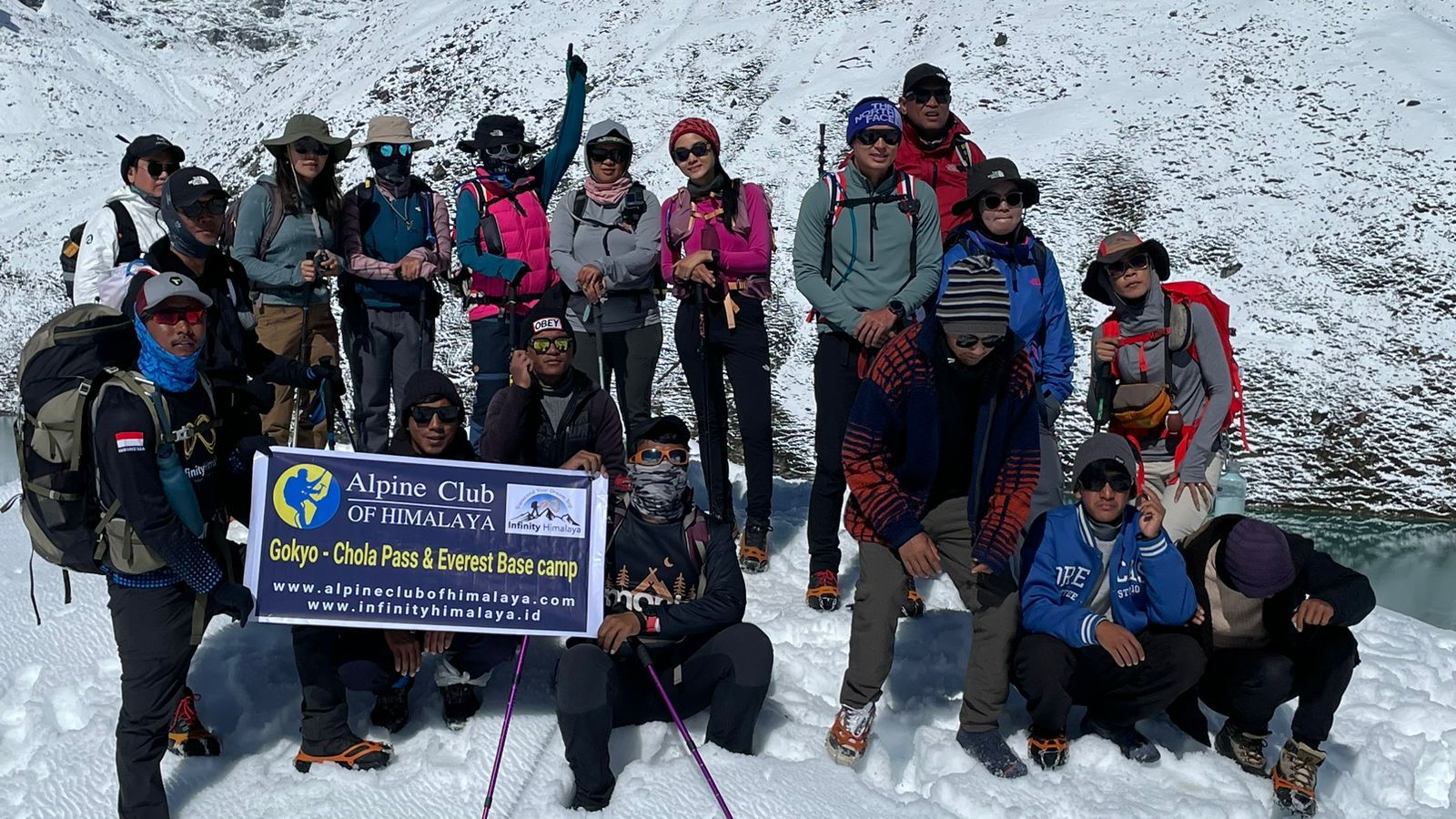








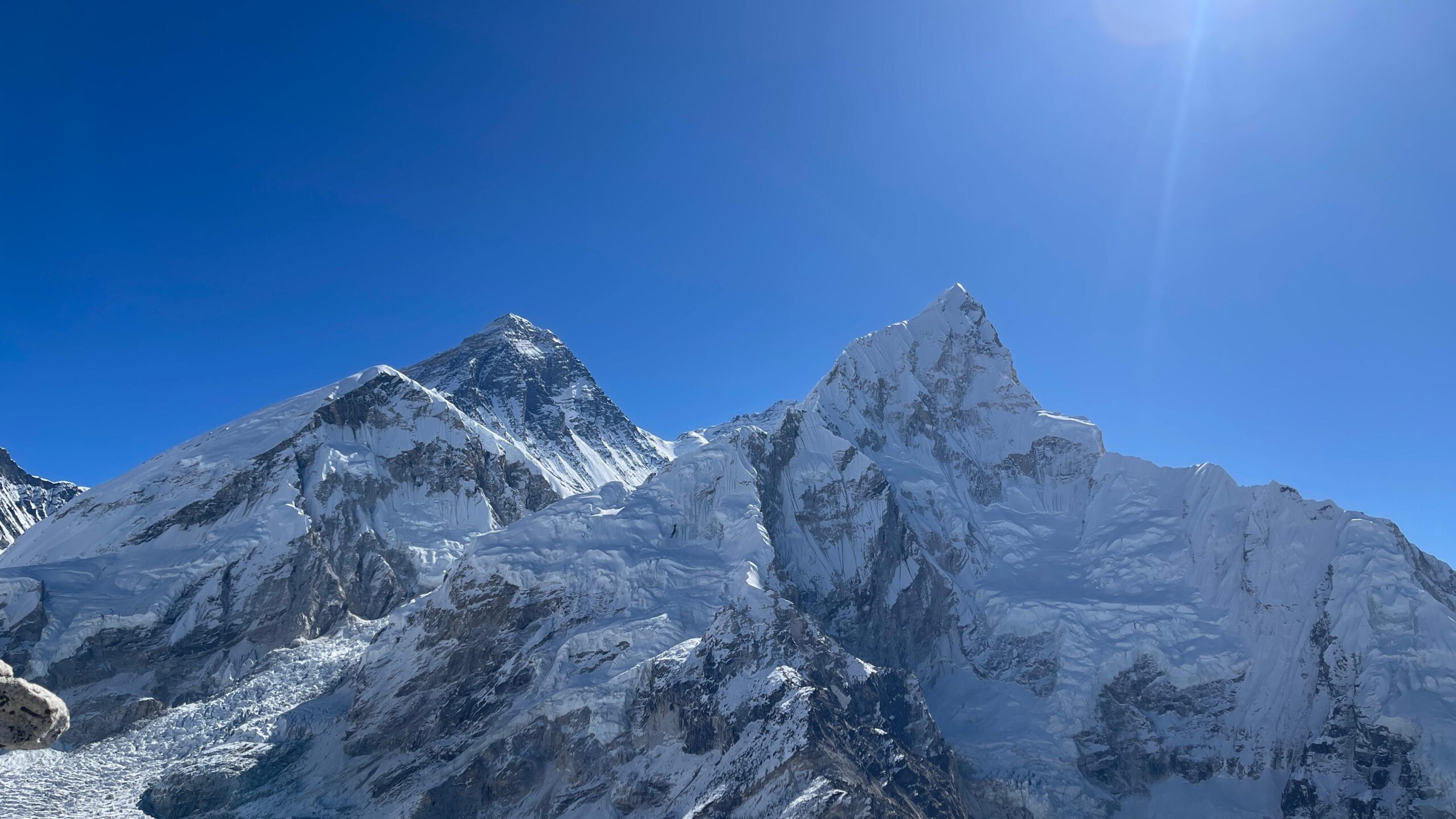
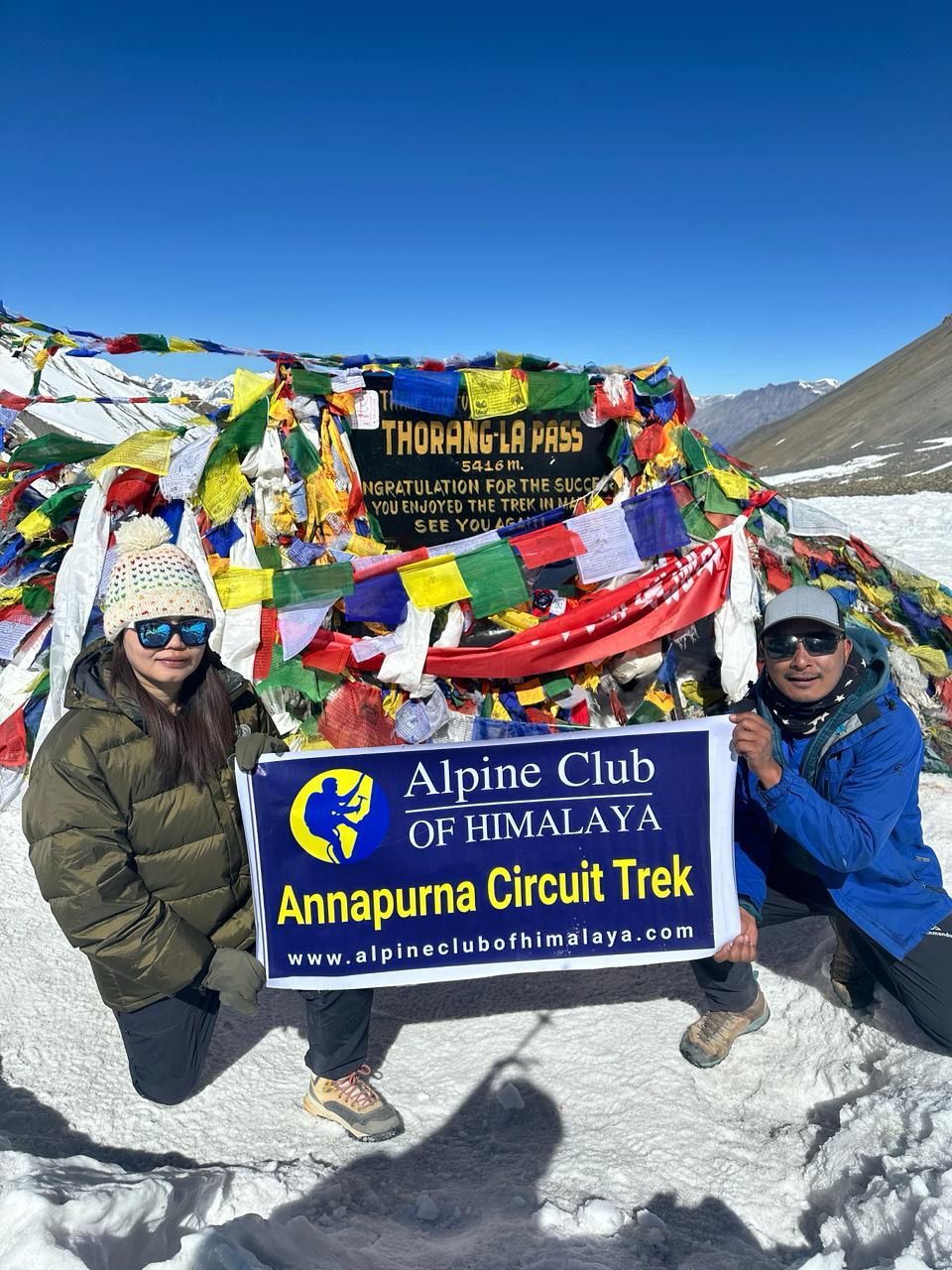
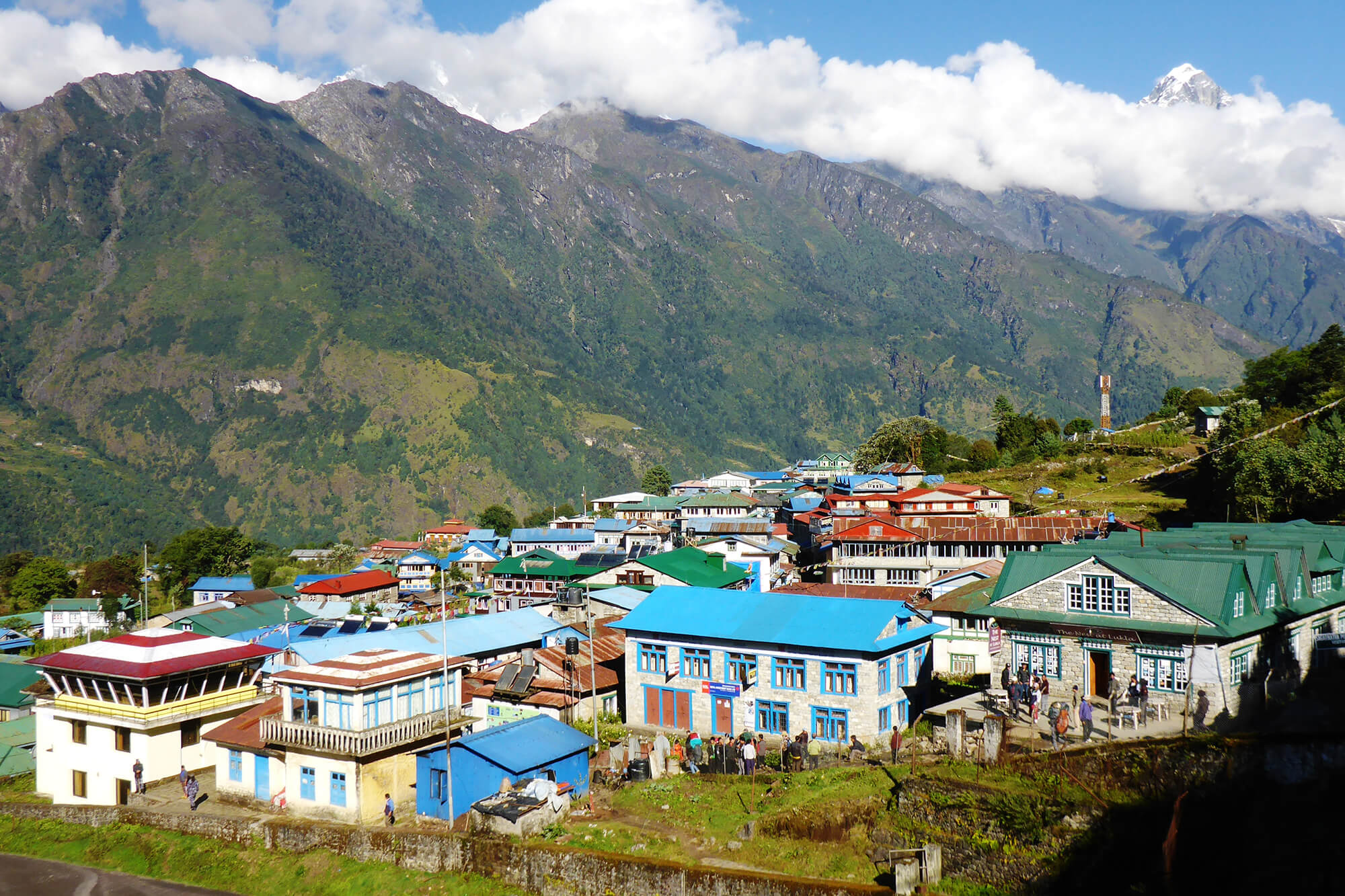
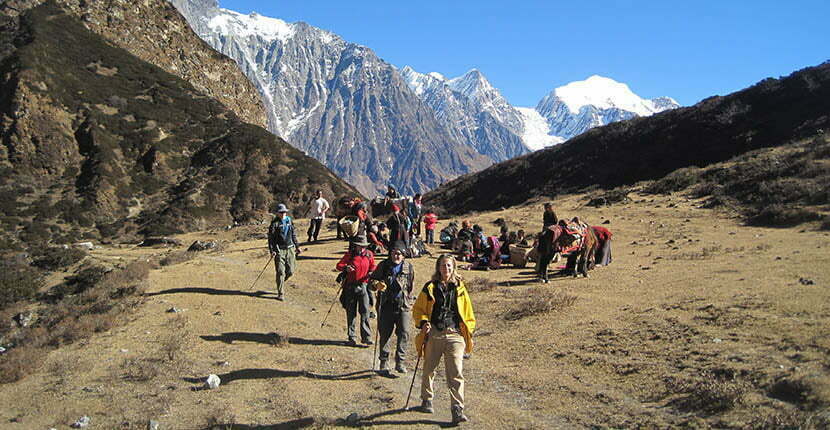
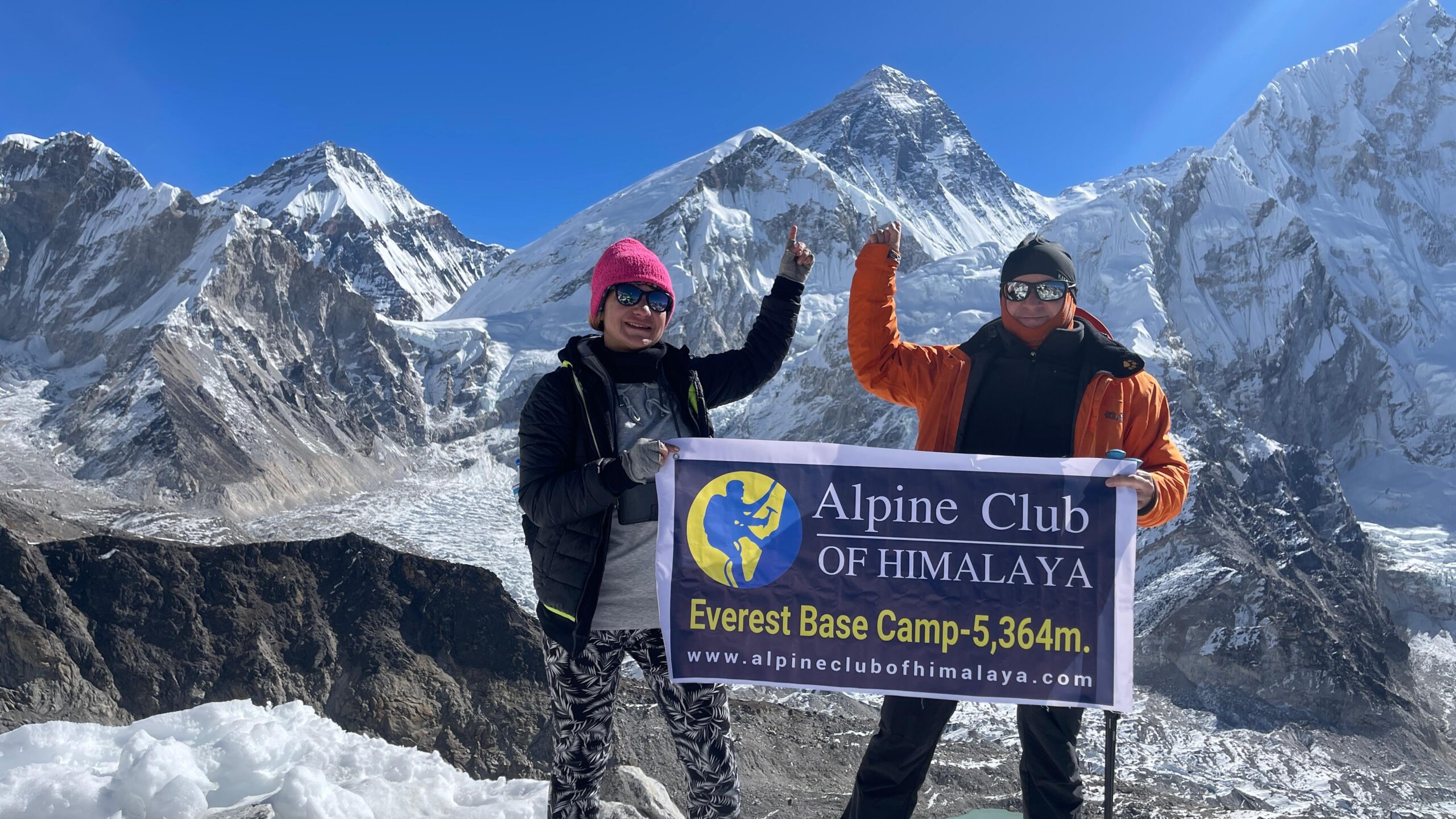
Write a Review